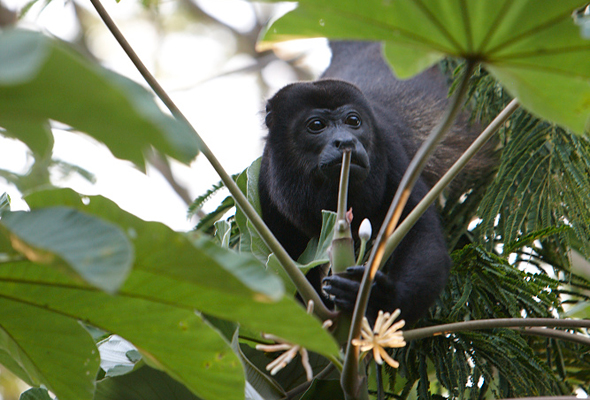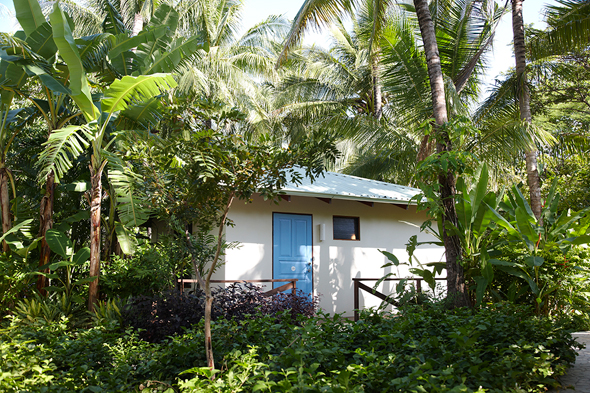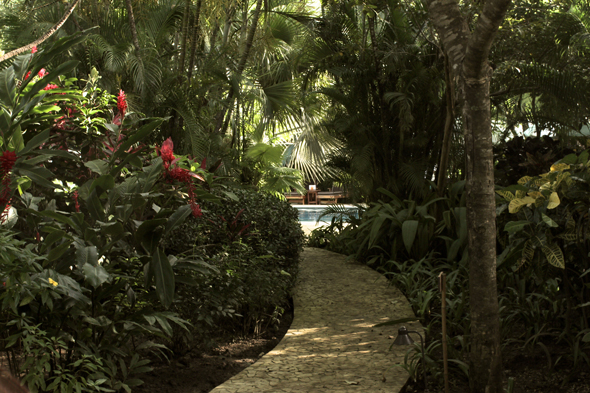MONKEY TRAILS
Lush landscaping provides a natural corridor for howler monkeys to travel from spot-to-spot, stopping for snacks along the way. Moving through the treetops, they avoid confrontations with dogs or traffic.
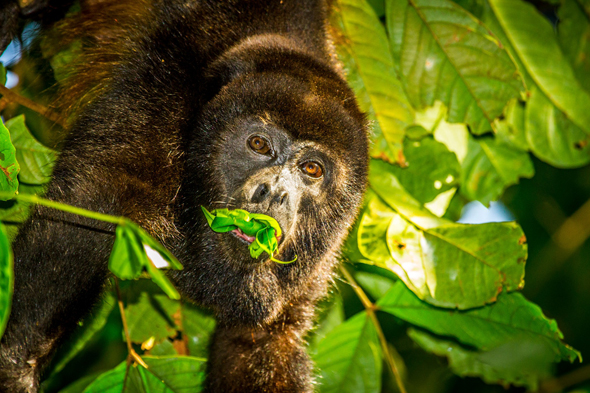
Click to open slideshow. Photos by Alvaro Cubero Vega and Kathleen Kyllo, reprinted with permission.
Last month I visited the Harmony Hotel where we saw native animals almost every day. Howler monkeys, so named for their deep guttural calls that sound like a roar, were among the many creatures we saw. As such a natural part of the scenery, it felt like the animals have always been there, but I learned that the howlers weren’t there even a decade ago. Their return tells an interesting chapter in the Harmony’s history that has involved a team of landscapers, gardeners and designers.
To understand the evolution of the Harmony Hotel, one must first understand what the previous hotel property was like upon initial renovation. According to Karen Arres, the landscaper who helped develop at the Harmony since its start, in 2005 there were very few plants on the property and virtually no wildlife. To attract native wildlife the landscapers would first have to create an environment that resembled the tropical forests where animals live, and grow the food that could sustain them.
When they began, landscapers could not find a resource of native plants that could accommodate the green space they had hoped to cultivate. Leaders at Harmony met with gardeners to devise a plan for growing their own native plants in a nearby nursery in Garza. During November of 2005, landscapers began planting the native trees alongside available non-native species, with the long-term intention of gradually replacing them.
In 2007 landscapers at Harmony setup a workshop with an organization called Pronatives to teach gardeners about the benefits of raising native plants. As a result, little by little the landscapers at Harmony have replaced non-native plants with those taken from Garza, which now has the largest native plant nursery in Costa Rica. It is an ongoing process that ensures each year the Harmony nears its goal of using plants native to Nosara.
Alongside learning which plants could enable animal wildlife at the Harmony, decisions about power lines also had to be made. The effects of installing electricity within the heart of a rich wildlife environment are complicated. One major concern for Costa Rica involves how these developments are affecting the howler monkey population. Monkeys are creatures of habit, and will regularly use the same path over and over again when traveling between trees. In this way, they are able to avoid confrontations with dogs or traffic. When new wires are built where one of these paths cross, very often monkeys will mistake a wire for a branch and find themselves burned or even killed. Nearly 100 monkeys were electrocuted in 2013, according to Brenda Bombard, the head of Nosara Wildlife Rescue, an organization that rescues and rehabilitates howlers like the 5-month old baby below.

In order to lure the monkeys back to the Harmony Hotel area safely, gardeners planted Balsa and Cecropia trees as they are some of the howler’s favorite foods. The trees were planted close together, creating what is sometimes called a monkey corridor, encouraging monkeys to travel safely through them. The power lines at the Harmony never cross where these monkey trails have been built, and as a result you can often find a family of Howlers eating leaves in the trees above the poolside at dusk.The trees also provide food for birds and iguanas, further nurturing and supporting a native eco-system.
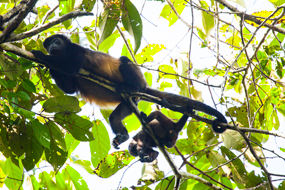 |
 |
Over time animals began returning to the Harmony Hotel. First there were birds, followed by iguanas, armadillos, raccoons and giant locusts. During our week every day we encountered a new animal we’d never seen; a large iguana might saunter casually by, or a pizote (a white faced mammal resembling a raccoon) might curiously appear at nighttime, as though invited to our patio discussions.

The experience of living among these animals for a time was something I had only ever known before in remote areas of India, and certainly never in a hotel like Harmony. Rather than feeling as though you’ve accidentally or exotically found yourself in confrontation with a strange animal, within a first day at the Harmony guests move easily through daily routines alongside the very species that are meant to thrive there. The vibe reflects an incredible sensitivity. It begs important questions about the necessity of separating hotels so far from the culture and climates of areas where they reside.
*To schedule a visit to the meet rescued howler monkeys or make a donation, go to Refuge for Wildlife.

